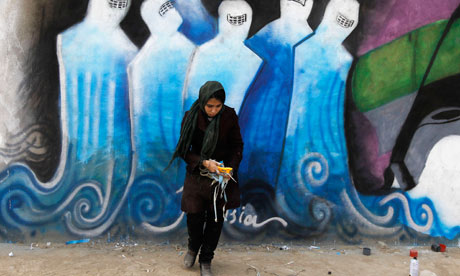Kate Nash has never
made a secret of the fact that she's inspired by the riot grrrl and
foxcore bands of the 90's. While this particular influenced simmered
just beneath the surface of her previous album, this time around it's
very much at the forefront, and that's no bad thing.
Though
some would disagree, to me this is still very much a Kate Nash album.
Her trademark personal and confessional lyrics are still there, but now
they're backed by guitars and catchy basslines.
Opening track Part Heart provides
a mellow and emotive introduction, allowing Kate's vocals to shine.
There's a vulnerability to the lyrics, but also a sense of strength as
the music builds up toward the end of the song.
Throughout the rest of the album, Kate swings between loud, punky tracks reminiscent of Bikini Kill and Hole (Sister, All Talk) and sweeter, melodic numbers (Are You There Sweetheart, OMYGOD)
with ease. It's not an album to listen to passively, in the background.
It's for full-on immersion, losing yourself and soundtracking your own
experiences.
A
lot of the songs seems to be built around a bass line, which is
something I appreciate as a bassist. I love it when you can actually hear the bass, when it's doing more than just playing along with the main guitar riff.
As
a longtime Kate Nash fan, this album was well worth the wait. It will
no doubt split opinions, but most interesting things do. To ditch a
proven formula and follow your passions is always a brave move, and it's
paid off here. Give it a listen.
Rating: 5/5
Favourite Tracks: Sister, OMYGOD!, All Talk
You Might Like It If You Like...: Hole, Babes in Toyland, Bikini Kill, Bratmobile, Le Tigre
Sunday, 24 March 2013
Tuesday, 5 March 2013
Girls' Portrayal of OCD
This week's episode of Girls, titled It's Back, took a slightly more serious direction with one its story lines - Hannah's returning OCD. Having had problems with OCD in the past (and still the occasional flare-up, though thankfully nowhere near as bad as it once was), I'm always interested to see it portrayed in the media. Unfortunately, accurate and respectful portrayals seem to be few and far between.
It seemed to come a little bit out of the blue - I don't remember Hannah's OCD being mentioned in the show before - but I recognised straight what was going on. Lena Dunham also spoke of her own experiences with OCD in an interview last month, so I'd hope a lot of regular viewers might have caught on quickly too.
Despite this, I was impressed with how Dunham portrayed Hannah's whole experience - from trying to deny that it's happening to feeling offended when you feel like someone is trying to minimise the distress it's causing you.
It's that distress that, I feel, gets left out a lot in media portrayals of OCD. I've spoken to so many people who didn't realise it was about more than a preference for being clean and tidy, having a dislike for germs. People who were genuinely surprised to hear that many people with OCD don't feel compelled to wash their hands repeatedly (this does seem to be the go-to compulsion for most TV shows). And very few people seem to realise just how upsetting it can be, what can be going on inside your head alongside these compulsions.
Hannah may not have went into detail about the thoughts in her head, but I do thin Dunham was able to get across the message that OCD isn't fun. At all. She was clearly unhappy and the conversation between her and the doctor hit so close to home for me, I definitely consider it a season highlight.
With this and My Mad Fat Diary recently being aired, I hope this isn't the last we see of mental illness being realistically shown on our screens.
Monday, 4 March 2013
Art Star: Shamsia Hassani
Shamsia Hassani, 24, is a graffiti artist in Afghanistan. In fact, she's the county's first female graffiti artist.
Hassani's introduction to graffiti came in 2010, when British artist Chu visited Afghanistan to hold a week-long course in street art. She embraced the art form, believing it to have more of an impact than traditional art.
Her main inspiration is highlighting the injustices against women; in one of her works, six women in blue burqas appear to have become ghosts as a result of there treatment by society. This blue burqas are a recurring feature in Hassani's work. The colour is a symbol of freedom.
She's also an associate professor of sculpture at Kabul University and a founding member of an art collective called ROSHD (or "growth"). Due to the risks involved, Hassani is currently the only woman in the group, although there were women when the group started.
As well as the street-harassment faced daily by women in Afghanistan, the government also has a zero-tolerance policy towards graffiti artists.
Graffiti is seen by many locals as being "un-Islamic", with artists like Hassani being too influenced by Western culture. For these reasons, Hassani's work is restricted to abandoned or unused buildings as opposed to the large, blank walls that exist in more public areas.
You can find out more about Hassani and see more of her artwork on her Facebook page.
Subscribe to:
Posts (Atom)



